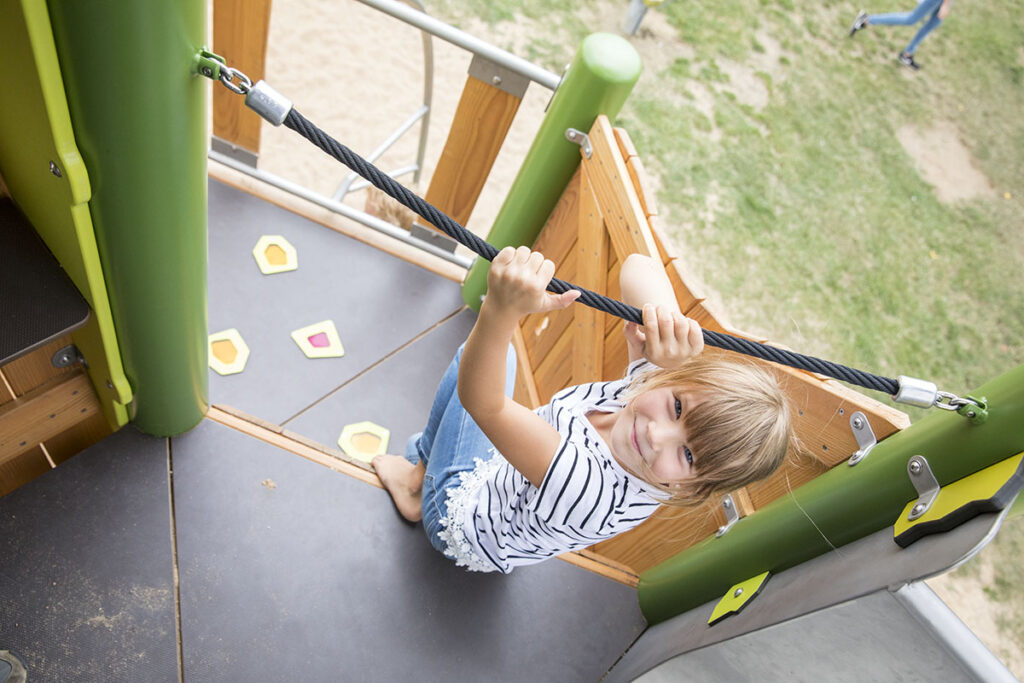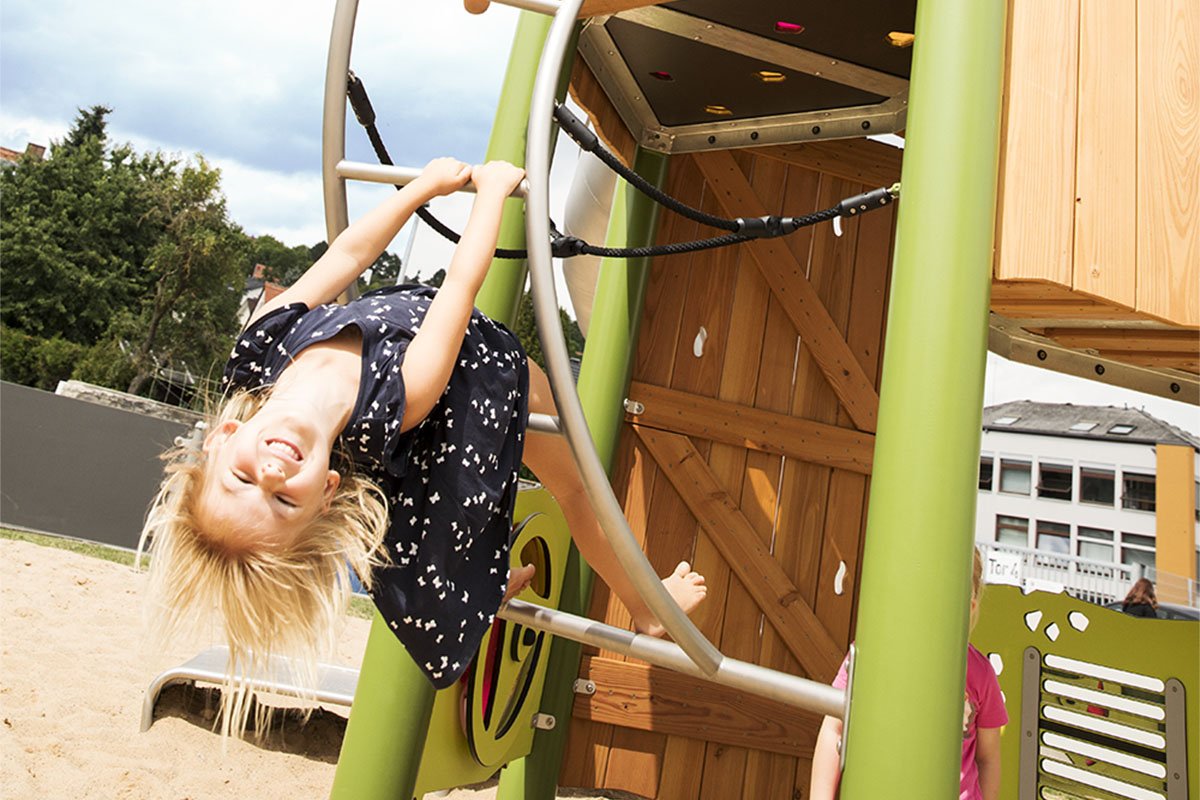Motivating children to movement? More important than ever these days! Just think about children’s everyday lives: six hours at school, if not more. The journey home by bus or in the parents’ car. Homework at the desk, then the well-deserved free time – in other words: gaming, streaming, surfing, chatting. In the age of digitalisation, the screen is the main source of fun. People socialise via the messenger of their choice or across the net. But there is hardly any movement. Maybe once in a while to move to a more comfortable position or to reach for the drink provided. In any case, it’s not sporty. Yet the human body needs sufficient exercise, especially in childhood.
The German national recommendation for the promotion of physical activity and exercise stipulates a daily physical activity time of 180 minutes for children of nursery school age (4 to 6 years). Primary school children (6 to 11 years) and adolescents (12 to 18 years) should exercise 90 minutes a day. According to the advice of the German Federal Ministry of Health, 60 minutes of this can be covered by everyday activities, e.g. by simply walking 12000 steps.
Table of contents
- Motivating children to movement – why is that important at all?
- How do I motivate my child to more physical activity?
- Motivating children to movement: Ideas for a more active life!
- How to bring movement into everyday life
Motivating children to movement – why is that important at all?
Physical acivity stimulates blood flow to the brain and therefore has a positive effect on the ability to concentrate. But it’s not just the oxygen that does the trick – a physically active child is a well-balanced child. Sitting quietly at school is no longer too difficult if you have already done enough exercise beforehand. Exercise reduces excess energy, which makes it easier to sleep at night. It helps against inner restlessness and nervousness. It also improves coordination and thus the child’s body awareness, which can prevent accidental injuries caused by uncoordinated movements. Regular exercise thus contributes to the child’s physical well-being all round. Especially if they take place in the fresh air. Motivating children to movement? For these very reasons, this is particularly important.
According to KiGGS, the German Robert Koch Institute’s long-term study on the health of children and adolescents in Germany, 15 % of children and adolescents are overweight or even obese. Obesity is present in 6.3 % of children and adolescents. These figures are due to the children’s unsuitable diet, but above all to the lack of exercise. This is because just 22.4 % of girls and 29.4 % of boys reach the daily exercise recommendation.
How do I motivate my child to more physical activity?
Set a good example – literally!
Children learn their behaviour from their parents. So it definitely plays a role how active you are in everyday life. Why don’t you reflect on your habits? Do you move around a lot or do you spend a lot of your free time sitting down? Do you walk a lot or do you use the car for short distances? What is true for your child is also true for you: regular exercise has a positive effect on the body. For example, it stimulates the metabolism and strengthens the cardiovascular system. It is also an excellent home remedy against stress. You don’t have to be a sports fanatic to get enough exercise. If you don’t like jogging, for example, a long walk will do just as well. After all, any exercise is better than no exercise. Would you like to motivate your child to exercise more? Then make a good start by setting an example of the right attitude.
Joint activities provide movement.
The principle is simple: You want your child to move? Then move with them. The easiest way to motivate children to more physical activity is to do something with them. Get off the couch – it’s time to go outside!

Motivating children to movement: Ideas for a more active life!
- Go for a swim: Splashing around in the indoor pool is fun in good or bad weather. Why not challenge your child to a spontaneous swimming competition? The first one to reach the other side of the pool wins! And who can dive the deepest? Water playgrounds also entice children to be active.
- A trip to the forest is not only adventurous, but also offers plenty of opportunities for exercise. Fallen trees can be used playfully as sports equipment. If you don’t feel like it, you can collect acorns and chestnuts or throw pine cones.
- Hiking tours: It doesn’t have to be a day hike – it’s up to you how far you walk. There are hiking trails almost everywhere. Let your child look for a walking stick on the way or use the excursion to explain different types of trees and plants. You can also fill the breaks with a picnic.
You don’t have time for long excursions right now? No problem.
After all, joint activities do not necessarily have to involve a lot of time and planning!
- Fun in the garden…
Games like tag, hide-and-seek or even role-playing are perennial favourites, especially with younger children. If you want something a little more unusual, try spider racing. The children move on all fours with their backs turned to the ground. The one who crawls the fastest wins! - … and fun in the city!
Every city has a public park where you can have just as much fun as in the garden. Sports toys provide the necessary momentum – a water polo, a Frisbee or a badminton game will keep the children busy for a while and encourage them to move. A trip to the park can also be combined with a walk there.
How to bring movement into your everyday life
- Use the stairs: Leave the lift alone and take the stairs instead. This not only provides an extra dose of exercise, but is also an excellent workout for your leg muscles.
- Walk instead of drive: Work, school – all within easy walking distance? Then take advantage of this and leave your car in the garage. This saves fuel and prevents you from having to search for a parking space. By the way: Walking to school on your own promotes your child’s independence.
- And at the weekends? A morning walk to the bakery can become a nice family ritual. Fresh air and exercise – all in one. And afterwards, there’s a delicious breakfast at home!
- Walks with the dog offer a meaningful employment opportunity and a great way to motivate your child to movement. If you don’t have your own dog, you can ask the neighbour for permission to walk their dog. And if there’s an animal shelter within reach, they’re always happy to have volunteers to walk the dogs, too.
- Dare to go out: Rain is a reason but not an obstacle. Rainproof clothing and waterproof shoes make it possible to go for a walk together even in dirty weather. Allow your child to jump into a few puddles – a little water like that doesn’t hurt anyone and there are dry towels waiting at home.
- Spontaneous dance parties: Sounds silly, but it is. But they are a lot of fun. Call a disco state for five minutes. Who can dance the funniest? Turn on the music and go!
As nice as the idea is – not every child is enthusiastic about joining a sports club. That’s okay, you don’t want to force your child to do anything. However, you should motivate your child all the more to physical activity in everyday life. Studies have shown that exercise not only promotes children’s health, but also their education. Read “Education through movement! The playground promotes learning” and learn more about the connections between education and movement.

